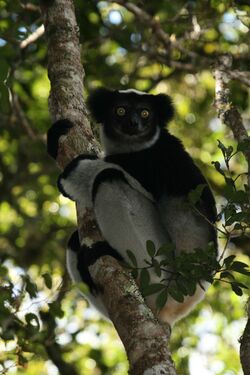Indri indri (Indri): Difference between revisions
imported>Lee R. Berger (Creating indri) |
imported>Lee R. Berger (editing) |
||
| Line 2: | Line 2: | ||
The '''Indri''' ''Indri Indri'' is the largest living [[Lemur]]. In the wild, it is found only on the island of [[Madagascar]]. | The '''Indri''' ''Indri Indri'' is the largest living [[Lemur]]. In the wild, it is found only on the island of [[Madagascar]]. | ||
==Description== | |||
The Indri has a head body length of approximately 64 – 72 cm and has a stubby vestigal tail <ref name="Fleagle">{{cite book|title=Primate Adaptation and Evolution|accessdate=|author=J. Fleagle|authorlink= |coauthors= |date=1998 |format= |work= |publisher=Academic Press: New York|pages= |language= |archiveurl= |archivedate= |quote= }}</ref><ref name="Szalay">{{cite book |title=Evolutionary History of the Primates|accessdate=|author=F. Szalay and E. Delson|authorlink= |coauthors= |date=2001 |format= |work= |publisher=Academic Press, New York|pages= |language= |archiveurl= |archivedate= |quote= }}</ref><ref name="Mittermeier">{{cite book|title=Lemurs of Madagascar|accessdate=|author=Mittermeier et al.|authorlink= |coauthors= |date=2006 |format= |work= |publisher=Conservation International|pages= |language= |archiveurl= |archivedate= |quote= }}</ref>. Weight ranges between approximately 6kg up to almost 10kg <ref name= "Mittermeier"/>. Coat color varies from predominantly black contrasting with a white pygal patch and paler facial ring, to variegated black and white<ref name= "Mittermeier"/>. Males can be difficult to distinguish from females, but in the [[Analamazaortra Special Reserve]] males are slightly larger than females and there is slight dimorphism in color pattern<ref name= "Mittermeier"/>. | The Indri has a head body length of approximately 64 – 72 cm and has a stubby vestigal tail <ref name="Fleagle">{{cite book|title=Primate Adaptation and Evolution|accessdate=|author=J. Fleagle|authorlink= |coauthors= |date=1998 |format= |work= |publisher=Academic Press: New York|pages= |language= |archiveurl= |archivedate= |quote= }}</ref><ref name="Szalay">{{cite book |title=Evolutionary History of the Primates|accessdate=|author=F. Szalay and E. Delson|authorlink= |coauthors= |date=2001 |format= |work= |publisher=Academic Press, New York|pages= |language= |archiveurl= |archivedate= |quote= }}</ref><ref name="Mittermeier">{{cite book|title=Lemurs of Madagascar|accessdate=|author=Mittermeier et al.|authorlink= |coauthors= |date=2006 |format= |work= |publisher=Conservation International|pages= |language= |archiveurl= |archivedate= |quote= }}</ref>. Weight ranges between approximately 6kg up to almost 10kg <ref name= "Mittermeier"/>. Coat color varies from predominantly black contrasting with a white pygal patch and paler facial ring, to variegated black and white<ref name= "Mittermeier"/>. Males can be difficult to distinguish from females, but in the [[Analamazaortra Special Reserve]] males are slightly larger than females and there is slight dimorphism in color pattern<ref name= "Mittermeier"/>. | ||
Its movement is described as vertical climbing and leaping and maintains a preferential upright body posture<ref name= "Mittermeier"/>. The indri has a loud vocalization which has been described as an “eerie wailing song” <ref name= "Mittermeier"/> | Its movement is described as vertical climbing and leaping and it maintains a preferential upright body posture<ref name= "Mittermeier"/>. The indri has a loud vocalization which has been described as an “eerie wailing song” <ref name= "Mittermeier"/>which can be reminiscent of the singing of some whale species. | ||
==Geographical distribution== | ==Geographical distribution== | ||
Revision as of 01:19, 6 September 2007

The Indri Indri Indri is the largest living Lemur. In the wild, it is found only on the island of Madagascar.
Description
The Indri has a head body length of approximately 64 – 72 cm and has a stubby vestigal tail [1][2][3]. Weight ranges between approximately 6kg up to almost 10kg [3]. Coat color varies from predominantly black contrasting with a white pygal patch and paler facial ring, to variegated black and white[3]. Males can be difficult to distinguish from females, but in the Analamazaortra Special Reserve males are slightly larger than females and there is slight dimorphism in color pattern[3].
Its movement is described as vertical climbing and leaping and it maintains a preferential upright body posture[3]. The indri has a loud vocalization which has been described as an “eerie wailing song” [3]which can be reminiscent of the singing of some whale species.
Geographical distribution
The indri may be found in tropical moist lowlands and montane forests of eastern Madagascar[3].